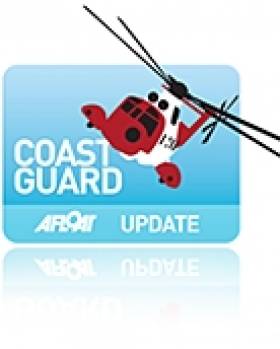Displaying items by tag: ardglass
Wet, Shocked but Unharmed, Two Crew Plucked from Liferaft off Ardglass
At 4.40pm Belfast Coastguard were notified through MRCC Clyde that Falmouth Coastguard had received an EPIRB from the fishing vessel 'Islander' that was believed to be fishing in their area. Just afterwards Belfast Coastguard received reports of a flare and wreckage just of Ardglass, Northern Ireland.
Fishing vessel 'Golden Shore' went to investigate and found the Islander's two crew in a life raft. They were wet, shocked but unharmed.
Ian Murdock Belfast Coastguard Watch Manager said:
"Despite the dramatic and rapid loss of their vessel this crew were prepared for this eventuality. They were able to raise the alarm quickly and are tonight safe and well.
"This swift resolution of what could have been a life ending incident is the reason that we recommend that all vessels are fitted with an EPIRB which can automatically send a distress alert and, give an accurate position of your vessel to the Coastguard with through a satellite based rescue system
Portaferry RNLI Rescues Four from Fishing Vessel
The Portaferry RNLI lifeboat was involved in the rescue of four men from a fishing boat that ran aground off the coast last Monday evening, the Belfast Telegraph reports.
The lifeboat along with the Portaferry and Newcastle Coastguard and and Irish Coast Guard helicopter from Dublin responded to a distress call from a 60ft trawler that ran into difficulties close to Ardglass harbour.
All four men on board were rescued and treated by paramedics on scene, and the vessel was later refloated.
Related Safety posts
RNLI Lifeboats in Ireland
Safety News
Rescue News from RNLI Lifeboats in Ireland
Coast Guard News from Ireland
Water Safety News from Ireland
Marine Casualty Investigation Board News
Marine Warnings
Fishermen Rescued From Sinking Vessel off Ardglass
Belfast Coastguard received a Mayday call at 5:54pm from the Newry registered vessel, which operates out of Ardglass, and immediately sent the Southdown and Portaferry Coastguard Rescue Teams to the scene. The launch was requested of the RNLI Portaferry inshore lifeboat. The Irish Coastguard Rescue Helicopter was tasked but was later stood down.
Steve Carson, Watch Manager, Belfast Maritime Rescue Coordination Centre, said:
"The crew aboard the fishing vessel were rescued by the inshore lifeboat and then taken to Ardglass Harbour where they received medical attention; one of the crew has since been taken to Downpatrick Hospital.
It is imperative to always ensure you are carrying the correct safety equipment and have it serviced regularly. Due to the prompt and appropriate action of the crew I am pleased to say they are all safe but shaken by their traumatic experience.
The rescue was successfully coordinated by Belfast Coastguard with assistance from their colleagues at Dublin, Liverpool and Holyhead Coastguard Stations.
The vessel has now been successfully refloated and is now alongside in Ardglass Harbour."































































